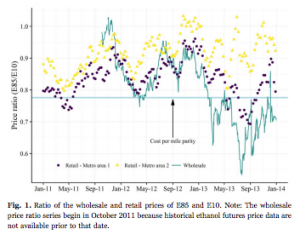When fuel prices are competitive, drivers of flex fuel vehicles (FFV) will fill up with high-ethanol blends such as E85 according to a new article published in Energy Policy. Authors Sébastien Pouliot and, Bruce A. Babcock also found that the recently finalized RFS requirement for 2017 for 15 gallons of conventional biofuels is in fact achievable with current infrastructure and vehicles.
 Looking at particular metro areas, the study examined actual consumer response to changes in E85 prices. The research determined that E85 use could grow to 1 billion gallons in these metro areas if E85 is priced right – a 20 percent savings on fuel costs per mile. The authors write, “With 14 billion gallons of ethanol consumed as E10, and additional E85 consumption in rural areas, total ethanol consumption at current prices is likely high enough to meet a 15 billion gallon blending target.”
Looking at particular metro areas, the study examined actual consumer response to changes in E85 prices. The research determined that E85 use could grow to 1 billion gallons in these metro areas if E85 is priced right – a 20 percent savings on fuel costs per mile. The authors write, “With 14 billion gallons of ethanol consumed as E10, and additional E85 consumption in rural areas, total ethanol consumption at current prices is likely high enough to meet a 15 billion gallon blending target.”
The study area equated to around 50 percent of the total E85 market.
The authors continue, “The decision by EPA to propose to reduce RFS ethanol mandates in 2014, 2015, and 2016 on the basis that consumer demand for ethanol is insufficient to meet a 15-billion-gallon target was based on EPA’s belief that too few owners of FFVs will switch to E85 if is it attractively priced to save them money and/or that there is insufficient incentive in the market-based RIN trading system to facilitate expansion in the number of stations that sell E85. Our analysis provides EPA and others with improved knowledge of the proportion of urban FFV owners that will buy E85 at different price points. Our results indicate that a significant proportion of FFV owners in metro areas will buy E85 if it is priced to save them money on a cost-per-mile basis. In one metro area that has one E85 station for every 2,070 FFVs, the market share of E85 exceeded 15% when E85 saved flex motorists a small amount of money.”
In response to the study finding, Renewable Fuels Association (RFA) President and CEO Bob Dinneen noted, “This research provides hard evidence that FFV drivers increasingly choose E85 when it saves them money. This may seem like an obvious conclusion, but some opponents of the RFS—and even EPA, at times—have questioned whether FFV drivers truly buy more E85 when its price falls relative to gasoline. The key takeaway from this study is that we have enough FFVs and E85 pumps already in place to easily satisfy the 15 billion gallon RFS requirement for conventional renewable fuel in 2017. And, more blender pumps are being added daily, which further increases competition and consumer access to lower-carbon, higher-octane flex fuels like E85, E20, and E30. The report serves as even more confirmation that EPA absolutely made the right decision by putting the RFS back on track in 2017.”

